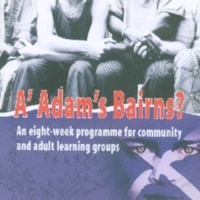
A' Adam's Bairns? Exploring equality and diversity in Scotland past and present
A’ Adam’s Bairns? is an educational resource pack produced in 2007 by a partnership of the National Library of Scotland and the Scottish Development Education Centre (Scotdec). The project explored equality and diversity both past and present, and looked at the attitudes and behaviours which underpinned slavery then and now, such as racism, sectarianism, prejudice and ignorance. The resources and reference materials are aimed at school children and also community and adult learning groups. They made use of material held by the National Library of Scotland and the National Archives of Scotland, and also included contemporary and traditional music produced by Scottish music expert Dr Fred Freeman, including a rendition of 'The Slave's Lament' by Robert Burns. Modules on the programme included slavery, forced movement of people and taking action for change.
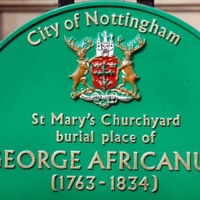
Rededication service for George Africanus
George John Scipio Africanus (1763-1834) was Nottingham's first recorded black entrepreneur, starting an employment agency called the 'Africanus Register of Servants'. As a child, Africanus was brought to England from Sierra Leone and given as a present to wealthy Wolverhampton businessman Benjamin Molineux. He then moved to Nottingham and became a freeholder. Nottinghamshire Archives and MLA East Midlands produced web resources for teachers and learners based on the life of George Africanus. An exhibition toured venues around the city, including Nottingham Council House and Brewhouse Yard. On 25 March 2007, as part of the bicentenary events in Nottingham, a service was held at St Mary's Church led by the Bishop of Kingston (Jamaica), the Rt Revd Robert Thompson. A new memorial stone was dedicated to Africanus, and a plaque unveiled commemorating his life.
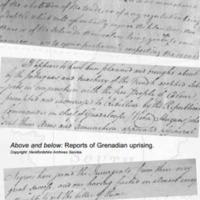
Unfair Trade
A touring exhibition from Herefordshire Museums, which explored Herefordshire's hidden history of slavery. Local connections include Moccas Court near Hereford, the country house once home to the Cornewall family, owners of a sugar plantation on Grenada at the time of the Grenadian uprising of 1795. Another county connection to the history of slavery is Lady Hawkins' School in Kington, the construction of which was bequeathed in 1632 by the widow of Sir John Hawkins, England's first slave trader. The nineteenth-century poet and abolitionist Elizabeth Barrett Browning also had family connections in Herefordshire. The exhibition was taken on tour around Herefordshire and Warwickshire on a specially commissioned Abolition Bus.
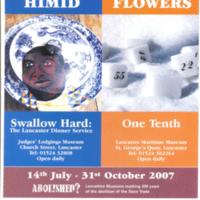
Abolished? Lancashire Museums marking 200 years of the abolition of the Slave Trade
Lancaster was the UK's fourth largest slaving port at the height of the transatlantic slave trade in the 18th century. Lancashire Museums worked with a range of partners to raise awareness of this largely hidden history - first from 2002 through STAMP (the Slave Trade Arts Memorial Project), and in 2007 through Abolished? This bicentenary project consisted of exhibitions, creative writing, radio broadcasts, and schools projects, one of which produced a Slavery Town Trail that explored some of the buildings made possible by the wealth the slave trade brought to Lancaster. At the heart of the project were commissioned installations and interventions by artists Lubaina Himid ('Swallow Hard: The Lancaster Dinner Service' at the Judge's Lodgings) and Sue Flowers ('One Tenth' at Lancaster Maritime Museum). Both were accompanied by outreach programmes and workshops with local schools. A touring exhibition was produced in partnership with Anti-Slavery International and Lancashire County Council Youth and Community, which looked at transatlantic slavery and modern day slavery. The exhibition toured throughout Lancashire.
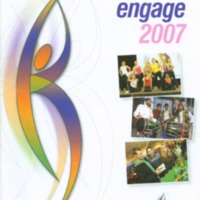
Engage 2007
The Engage 2007 Festival of Culture celebrated cultural freedoms in South Gloucestershire. Led by South Gloucestershire Council, and in partnership with local volunteer groups, schools and community groups, the festival took place on 17 November 2007. It featured 40 live performances of drama, dance and music from India, China, Africa, South America and Europe, a world food zone, family workshops, youth and environmental activities and 60 interactive and information stalls. The Impact exhibition was produced as part of Engage 2007, exploring the part that people living in South Gloucestershire played slavery and abolition.
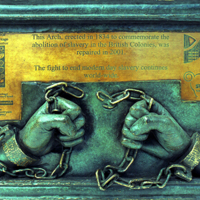
Anti-Slavery Arch, Stroud
The Anti-Slavery Arch in Stroud is Britain's oldest anti-slavery memorial. It was built by Henry Wyatt in 1834 to celebrate the passing of the Abolition of Slavery Act of 1833. A local businessman and supporter of the Stroud Anti-Slavery Society, Wyatt built the arch as an entrance to the carriage drive of his private estate. Established in 2000, the 'Anti-Slavery Arch Group' raised funds to address the preservation needs of the arch. This community project carried out major stone repairs, added a bronze plaque, produced a leaflet and website, and wrote and performed a play with students from Archway School (built on the site of Wyatt's mansion in the 1960s). In 2007, the monument was upgraded from a Grade II listing to Grade II*.
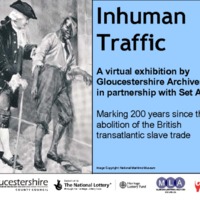
Inhuman Traffic
The Inhuman Traffic project was led by Gloucestershire Archives, in partnership with the Set All Free initiative. The virtual exhibition and accompanying web resource were based on documents held at Gloucestershire Archives and, in particular, the papers of the anti-slavery campaigner Granville Sharp (1735-1813). The exhibition explored topics such as the contribution of black people to the abolition movement, aspects of the legacies of slavery, including racism and domestic violence. Over 400 copies of the exhibition DVD were sent to schools, churches, tourist information venues and individuals across Gloucestershire. The associated programme of events included performances of the play 'Inhuman Traffic', developed in collaboration with a local theatre company, Spaniel in the Works. The play features four interacting characters with different perspectives on slavery. A cross-curricular teaching resource was later developed, which included a second performance, 'Master and Slave', in partnership with Stroud District Museums Service, Spaniel in the Works, and Parliament Primary School, Stroud.
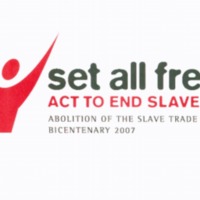
Set All Free: ACT TO END SLAVERY
Set All Free: ACT TO END SLAVERY was a project of Churches Together in England, based in London. It was also a collaboration between church-related groups, societies and organisations around the UK working together with a Christian ethos to assess the relevance of the bicentenary, and in particular the legacies of slavery. The project aimed to highlight how the values of the abolitionists can transform relationships on an individual, community and society level. The project included building a network coalition, campaigning, producing research and resources for churches, schools and individuals. Set All Free also worked closely with Anti-Slavery International and Rendezvous of Victory, a leading African community-led organisation.
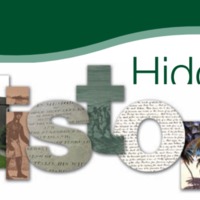
Hidden History of the Dales
This project was a collaboration between the Dales Countryside Museum in Hawes and North Yorkshire Record Office to research people and places of the Yorkshire Dales connected with Africa, the Caribbean and India. 'Hidden History' collected local stories of slave owners and traders, abolitionists, Africans and Asians who moved to the Dales, and others like the actor Ira Aldridge who passed through. The project included various community activities. Working with actor Joe Williams, pupils from the Wensleydale School explored the life of Olaudah Equiano and performed alongside Joe at the exhibition opening. There were drop-in sessions on exploring family history, carnival costume making, talks and music. The exhibition toured to other locations in Yorkshire, including Boroughbridge Library. The Dales Countryside Museum has continued to collect information relating to individuals who were connected with the Yorkshire Dales and the wider world.
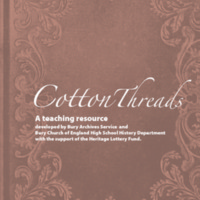
Cotton Threads
Bury Archives and Museum collaborated on an exhibition based on the journals, letters and other papers of John Hutchinson. The Hutchinson family's cotton spinning business had links to slavery in the United States: in 1848, John Hutchinson travelled to America to buy cotton produced by slaves. The exhibition at Bury Art Gallery featured archives, museum objects and paintings that put the papers into a social context. Cotton Threads went on tour to branch libraries, where talks and family workshops explored family histories and the cotton business. Volunteers assisted in conserving, cataloguing and digitising the Hutchinson papers, which were made available online. Primary school pupils took part in workshops held in the exhibition and a resource pack for secondary schools was produced with local teachers (available to download from the Cotton Threads website).
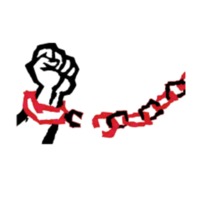
Slave Trade Abolition in Cambridgeshire & Suffolk (STACS)
The Slave Trade Abolition in Cambridgeshire & Suffolk (STACS) project was managed by St John's College at Cambridge University (the former college of the abolitionists Thomas Clarkson and William Wilberforce). Working with local schools, the project aimed to raise awareness of the often overlooked roles played by Thomas Clarkson and Olaudah Equiano within the slave trade abolition movement in East Anglia. Drama workshops led by two historical enactors led to student performances of their plays about the abolition movement. Two public presentations run by students, one in Cambridge and another at the Ipswich Caribbean Association, discussed and debated why the counties of Cambridgeshire and Suffolk should remember the life and work of Equiano and Clarkson. The final outcome of the project was the publication of new teaching resources and curriculum material to introduce students to the work of Equiano and Clarkson, and to place the transatlantic slave trade in local, national and international historical contexts. During the course of the project, BBC Radio 4 broadcast a Sunday worship service from St John's College, in association with 'Set All Free'.
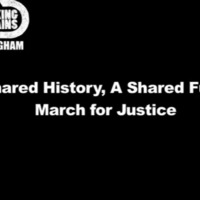
A Shared History, A Shared Future
A Shared History, A Shared Future was a series of projects led by Birmingham Libraries to engage with different communities within Birmingham. The project as a whole identified archival materials, local historical documents and music with an emphasis on the diverse multicultural nature of historical and modern indentured slavery, and how it relates to everyday lives in Birmingham. Over 1000 participants from schools and community groups took part in over 150 workshops to create stories, artwork, banners, protests, games, films, dances, drama and performances. A resource pack, the liberty box, was produced to encourage community groups, youth groups and others to explore the issues of slavery. In August 2007, the project organised the March for Justice in Birmingham city centre, a recreation of the Quaker and philanthropist Joseph Sturge's march against slavery in August 1838. The day included an anti-slavery fashion show, a limbo performance, storytelling, African drumming, and a Slavery Question Time Special hosted by an actor representing Olaudah Equiano.
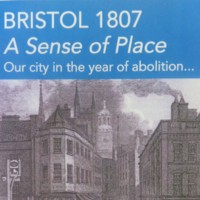
Bristol 1807: A Sense of Place
As part of the Abolition 200 programme, the Bristol 1807 project set out to explore the lives of ordinary Bristolians in 1807. An exhibition in the Central Library, and a series of touring exhibitions in Bristol's libraries and community centres explored society, culture, trade and travel in 19th century Bristol, a city and port with many ties to transatlantic slavery. The project collaborated with local schools to provide creative art workshops for children around themes of slavery and freedom. There were also 'Treasures in Store' hands-on sessions with rare library artefacts concerned with the period of abolition including books, newspapers and everyday objects. A book emerging from the project, 'Bristol in 1807: Impressions of the City at the Time of Abolition' by Anthony Beeson, was published in 2009.
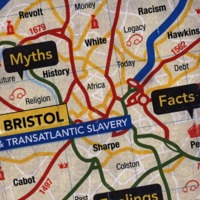
Myths, Facts, Feelings: Bristol and Transatlantic Slavery
The project to produce the booklet Myths, Facts and Feelings: Bristol and Transatlantic Slavery began in 2007. The Bristol Race Forum aimed to tackle some of the sensitivities, misunderstandings and popular opinions about the subject, and particularly in the Bristol area. The book's development went through a number of stages until it was published in 2012. The booklet and accompanying website for schools and communities across Bristol were produced with a view to sharing lessons from Bristol's past, and as a driver for future debate, activism and challenging prejudices. The contents were developed out of workshops with young people from the African Caribbean community and visits to community groups across Bristol.
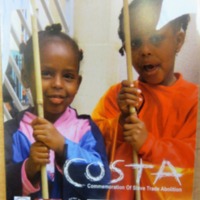
COSTA
COSTA stood for 'Commemoration of Slave Trade Abolition' and was a project of Sul'Art, a community art organisation in Bristol. Sul'Art delivered a programme of music, drama, art and dance to a number of schools and community groups to explore meanings of the bicentenary, working around themes such as migration, identity, celebration of difference, critiques of consumerism and intergenerational dialogue. Sul'Art also presented a number of performances of the professional jazz show ‘King Cotton’, dramatising the story of the cotton industry in music, song and film.
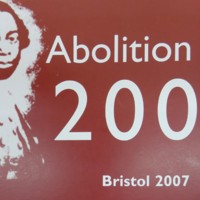
Abolition 200
Bristol was major trading port for the transatlantic slave trade in the 18th century. The city of Bristol marked the bicentenary of the Abolition Act with more than 100 events across the city - exhibitions, plays, debates, talks, concerts - under the umbrella organisation Abolition 200. In January 2007, city leaders signed a declaration of regret for the city's role in the trade. Over the weekend of 24-25 March, bells rang out across the city and a Service of Remembrance and Reconciliation was held at Bristol Cathedral, organised by a partnership of the Cathedral and the Council of Black Churches. 2007 was themed as the Year of Black Achievement, aiming to bring better provision of black heritage resources to schools in Bristol, with a particular focus on black attainment. Over 30 creative community projects were funded by Abolition 200 - including art installations, educational projects and community theatre - to reflect the themes of education, commemoration and legacy.
Featured here are some of the events from Abolition 200.
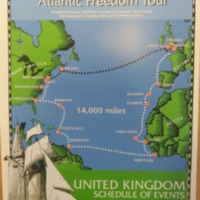
Amistad America's Atlantic Freedom Tour
A replica of the nineteenth-century slave ship Amistad visited Liverpool, Bristol and London as part of the Atlantic Freedom Tour in 2007-2008. The ship set sail from its home port of New Haven, Connecticut, on a 16-month 14,000 mile transatlantic voyage to retrace the slave industry triangle. The ship stopped at more than a dozen Atlantic ports, including Freetown in Sierra Leone. Students from the UK had the opportunity to join the crew of the schooner – a replica of the original ship commandeered by 53 of its African captives in 1839 – on one of its legs, and transmitted text, images and videos back to the classroom. At each UK port, the ship was open for guided tours. There were also accompanying lectures.
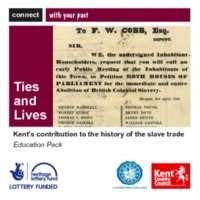
Ties and Lives: Kent and the Slave Trade
Ties and Lives: Kent and the Slave Trade was a project run by Kent Archives in collaboration with Creative Partnerships Kent and the educational charity Music for Change. It aimed to show how the county’s historic collections could be used by young people to support their education, particularly on contemporary issues. An education pack provided a range of sources, research and information for secondary schools about the abolition of slavery. Music for Change artists visited schools in the county and through performance workshops encouraged students to interpret stories found in the archive and local history collections and explore the impact of the transatlantic slave trade and the abolitionist movement on the past lives of Kentish people. There was a particular focus on music and dance originating from the traditions of enslaved peoples.
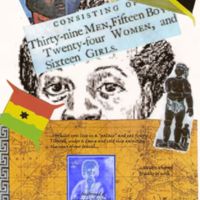
Hidden Stories
A collaborative project between Barnsley Archives and Local Studies, the Cooper Gallery and Cannon Hall exploring local connections to the slave trade. Cannon Hall is the ancestral home of the Spencer Family, who made their fortune in the local iron industry. In the mid-18th century, Benjamin Spencer became involved in the slave trade, and owned a slave ship called ‘Cannon Hall’; in contrast, Walter Spencer-Stanhope, who inherited the hall in 1775, supported the abolitionist movement. Pupils from local primary schools explored the hall’s connections to the slave trade and abolitionism, and produced artwork in response to the hidden histories, some of which were exhibited in the Cooper Gallery’s exhibition, ‘Witness’.
The ‘Hidden Stories’ project also explored the Crossley Family archive held by Barnsley Archives and Local Studies (Benjamin Crossley owned a sugar plantation in Jamaica). Barnsley Archives worked with the Barnsley Black and Ethnic Minority Initiative on a project to encourage black and minority ethnic groups in the Barnsley area to discover more about their roots. Other partners included Barnsley Out of School Study Support Network, Foulstone City Learning Centre and Just Addictive Music.
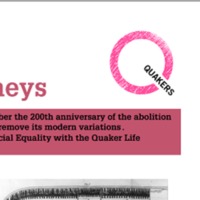
Quakers and the path to abolition in Britain and the colonies
The Society of Friends expressed its formal opposition to the slave trade in 1727, and from that date were vocal opponents of transatlantic slavery. A virtual exhibition of archived resources, ‘Quakers and the path to abolition in Britain and the colonies’, was launched online to commemorate the bicentenary. It traced the history of the anti-slavery movement from its Quaker beginnings and highlighted key events in the Quaker history of opposition to the slave trade, and was primarily based on material from the Library at Friends House. The exhibition also explained the important role played by Quaker women abolitionists through writing and poetry. The Quakers pioneered contemporary tactics such as boycotting, petitions, leafleting and poster campaigns.
Other resources to help people find out more about the bicentenary included ‘Abolition Journeys’, developed by Quaker Life Committee for Racial Equality with the Quaker Life Children and Young People’s Staff Team, designed to help people of all ages remember the slave trade and work to abolish its modern variations.